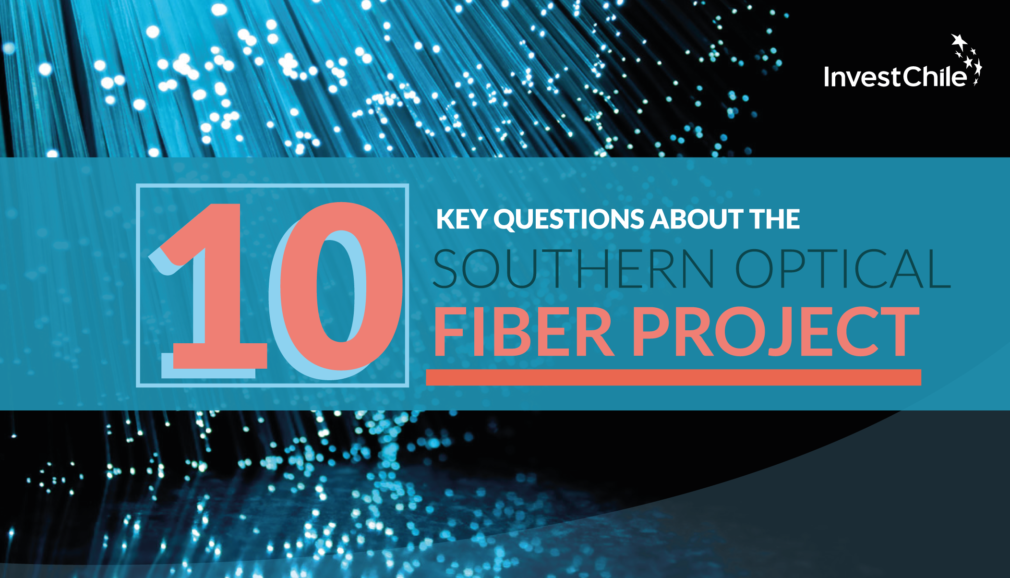
Essential information

10 key questions about the Southern Optical Fiber Project

In mid-May 2017, Chile’s Ministry of Transport and Telecommunications presented the term sheets for the Southern Optical Fiber Project. This initiative envisages the award of telecommunications infrastructure concessions for the construction of a high-speed digital highway to upgrade connectivity in Chilean Patagonia and put the country in a privileged position to reinforce its regional leadership on connectivity, becoming the point of digital connection between the Americas and the rest of the world.
- What does the project involve?
It involves the deployment of four optical fiber trunk telecommunications cables – three overland and one undersea – to connect the Los Lagos, Aysén and Magallanes Regions of southern Chile.
The submarine cable will be from Puerto Montt to Puerto Williams (the world’s southernmost node, close to Chilean Antarctica), with connections in Caleta Tortel and Punta Arenas, while the overland cables will run across the Los Lagos, Aysén and Magallanes Regions and must connect Punta Arenas with Tierra del Fuego.
- What will be the impact of the project?
In addition to the digital integration of the almost 300,000 inhabitants of Patagonia, the international impact of implementation of the Southern Optical Fiber Project includes the high potential for scientific research and development in the far south of Chile.
Currently at the stage of receiving bids, following the launch of the public tender on May 17, the Southern Optical Fiber Project envisages the award of telecommunications infrastructure concessions for the construction of a high-speed digital highway from Puerto Montt to Puerto Williams.
- What are the principal characteristics of the public tender?
The tender promotes the award of concessions for infrastructure with open and non-discriminatory access to telecommunications service concessionaires which will take the connectivity to the end users. The tender term sheets envisage the possibility that bidders form consortia and that, in return for the concession, the winner guarantees capacity for public bodies at a reduced tariff in order to ensure the implementation of public policy initiatives related to education, health and local social and economic development.
- What is the deadline established in the tender for the presentation of bids?
Under the terms of the tender, July 17 is the closing date for bids for the submarine cable and July 31 for the overland cables. The results are expected to be announced in October 2017.
- What does this project mean for Chile?
The deployment of this infrastructure will put Chile on a strong footing for larger-scale connectivity projects such as the Asia-Latin America Trans-Pacific Cable whose technical pre-feasibility study was recently received by Chile’s Undersecretariat of Telecommunications (SUBTEL).
This study was prepared by the Huawei technology company under a technical agreement signed with SUBTEL in mid-April and will serve for preliminary analysis of the options that exist for a direct connection between China and Chile.
- Is it possible to connect Chile and China through a submarine cable?
The technical study carried out by Huawei concluded that, within the next few months, the Chilean and Chinese governments will begin to explore the possibility of an optical fiber cable between Latin America and Asia-Pacific.
- How long would the submarine cable be and how much would it cost?
The initiative envisages an optical fiber connection with a length of between 20,000 and 24,000 kilometers over three possible routes, representing an investment of some US$650 million.
- What routes could be used to connect Chile and Asia-Pacific?
One of the routes would start in Valparaíso, with connections in the Juan Fernández Islands, Easter Island, Auckland (New Zealand) and Sydney (Australia), and end in Shanghai. Another option would also be between Valparaíso and Shanghai but would have connections in the Juan Fernández Islands, Easter Island and Tahiti (French Polynesia). The third alternative would be from Punta Arenas to Auckland with a connection in Shanghai.
- What are the long-term benefits?
According to the Undersecretary for Telecommunications, Rodrigo Ramírez “with the construction of this trans-pacific cable, Chile would become the digital port of entry between Asia and Latin America. As a country, we want to create this southern hemisphere optical fiber pole which would put Chile in a position of regional leadership as a digital hub, with the region’s best digital infrastructure, connecting Asia-Pacific with the southern hemisphere.”
“This is of great importance for the country and the region. It could be the largest optical fiber cable built so far and we, therefore, have to look in detail at whether its deployment is possible. If it were possible, it would be a milestone for Chile,” he added.
- Where can I find information about the tender?
For further information about the tender term sheets for the Southern Optical Fiber Project, go to http://www.subtel.gob.cl.
Source: SUBTEL







